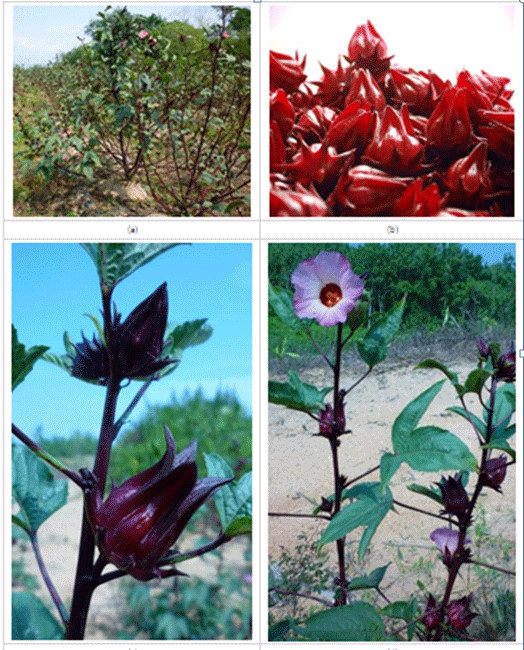Introduction
Plants have been long used as food and medication. One of plants that has potential as medicinal plant is Roselle. It is also can be used in food industries such as for production of jams, sauces and beverages.
Roselle is locally known as asam kumbang, asam susur and asam paya. Other names for Roselle in different languages are Lou shen hua (Chinese), Pulichai kerai (Tamil) and Red sorrel (English). Scientifically, Roselle is known as Hibiscus sabdariffa L. or also synonym with Abelmoschus cruentus and Furcaria sabdariffa. This plant can be found in tropical and subtropical regions such as Africa, India and Asia including Malaysia especially in Terengganu and Kelantan.
Description
The height of this plant can reach up to 8 feet (2.4 m) with branches that grow vertically in the early stages and more flexible when having fruit loads. The color of its stems and branches are red while its leaves are green and have palm-shaped with three lobes tapering to the tip. The dark red Roselle flower consists of five (5) large sepals in oval shape and appears on the leaf axils.
Traditional Use
Roselle is traditionally used for helping consumer to relieve or treat high blood pressure, liver disease and fever. In addition, it also may use as antibacterial, antifungal, lowers cholesterol level, diuretic agent and mild laxative Thai may use Roselle for treating kidney stone disease. The red pigment of petals can also be utilized as a food coloring agent.
Studies on Roselle
Parallel to the development of medical technology, many studies have been conducted to prove biological and pharmacological activities of Roselle. These studies were supported by experimental and clinical data that shown Roselle may contain chemical constituents such as amino groups (e.g., citric acid and malic acid), anthrocyanins (e.g. delphinidin-3-O-sambubioside), flavonoids (e.g., quercetin-3-glucoside), protein, fat, fiber and minerals.
These studies also demonstrated that anthrocyanins groups may give health beneficial to humans in diabetic nephropathy and liver protection, as well as have antioxidant, anti-inflammatory, anti-cholesterol and anti-hypertensive properties.
Traditional Medicines Containing Roselle
The quality and safety of traditional medicines are depending on it’s manufacturing process. Consequently, traditional or herbal medicines manufacturers should manufacture their medicines according to Good Manufacturing Practice (GMP) and should utilize raw materials of high quality.

One of elements in GMP requires these medicines to be critically examined before releasing to public. The examinations may involve physical, chemical and biological testing. The common types of physical testing are macroscopic, microscopic and colour testing. The information obtained from these tests may lead to confirmation of the plant raw materials used for example Roselle raw plant.
A chromatographic analysis is a common testing for chemical analysis. For instance, to confirm traditional medicines contain Roselle, delphinidin-3-O-sambubioside as chemical marker substances of Roselle can be detected using chromatographic analysis. A list of testing for Roselle can be found in website www.globinmed.com under Roselle Monograph.
Currently, there is still no information about side effects, adverse effects and toxicity due to consumption of Roselle. However, consumers who are taking diuretics or narrow- therapeutic drugs (e.g., digoxin, theophylline and phenytoin) should consult their doctor before taking medicines containing Roselle since it has been reported to cause natriuretic effects (high sodium excretion via urine). There are no studies or information on the use of Roselle for children, pregnant and breastfeeding mothers, and therefore, it is necessary to seek medical advice before taking this traditional medicine.
Consumers are strongly advised to choose traditional medicines that are compliance with GMP and registered with the Ministry of Health Malaysia. Consumers should also consult their physician if they experience persistent allergies and side effects when taking traditional medicines containing Roselle.
References
- Carvajal-Zarrabal et al. (2012). Hibiscus sabdariffa L., roselle calyx, from ethnobotany to pharmacology: Journal of Experimental Pharmacology 2012:4 25-39
- I.C. Rodriguez-Medina et al.(2009). Direct characterization of aqueous extract of Hibiscus sabdariffa using HPLC with diode array detection coupled to ESI and ion trap MS : J Sep. Sci. 2009, 32, 3441-3448
- Peng-Kong Wong et al. (2002). Physico-chemical characteristics of roselle (Hibiscus sabdariffa L.) : Nutrition & Food Science .Volume 32.Number 2. 2002. 68-73
- Fernandez-Arroyo, S., Rodriguez Medina, I.C., Beltran-Debon, R., Pasini, F., Joven,J., Micol,V., Segura-Carretero,A., & Fernandez-Gutierrez, A.,Quantification of the polyphenolic fraction and in vitro antioxidant and in-vivo antihyperlipemic activities of Hibiscus sabdariffa aqueous extract , Food Research International (2011)
- Lee WC, Wang CJ, Chen YH, Hsu JD, Cheng SY, Chen HC,Lee HJ. Polyphenol extracts from Hibiscus sabdariffa Linnaeus attenuate nephropathy in experimental type 1 diabetes. Journal of Agricultural and Food Chemistry .2009;57(6):2206-2210
- Wang CJ, Wang JM, Lin WL, Chu CY, Chou FP, Tseng TH. Protective effect of Hibiscus antocyanins against tert-butylhydroperoxide-induced hepatic toxicity in rats. Food and Chemical Toxicology .2000;(38)5:411-416
- Beltran-Debon, R.,Alonso-Villaverde C, Arogones G, Rodriguez Medina I, Rull A, Micol,V., Segura-Carretero,A., Fernandez-Gutierrez A, Camps J, Joven J.The aqueous extract of Hibiscus sabdariffa calices modulates the production of monocyte chemoattractant protein-1 in humans.Phytomedicine. 2010;17(3-4):186-191
- Chen CC, Hsu JD, Wang SF, Chiang HC, Yang MY, Kao ES, Ho YC, Wang CJ. Hibiscus sabdariffa extract inhibits the development of atherosclerosis in cholesterol-fed rabbits. Journal of Agricultural anf Food Chemistry.2003;51(18) :5472-5477
- Malaysian Herbal Monograph : Hibiscus sabdariffa L.
| Last Reviewed | : | 29 March 2015 |
| Writer/Translator | : | Aida Haryati bt. Abdul Rahim |
| Accreditor | : | Dr. Noraida bt. Mohamad Zainoor |







